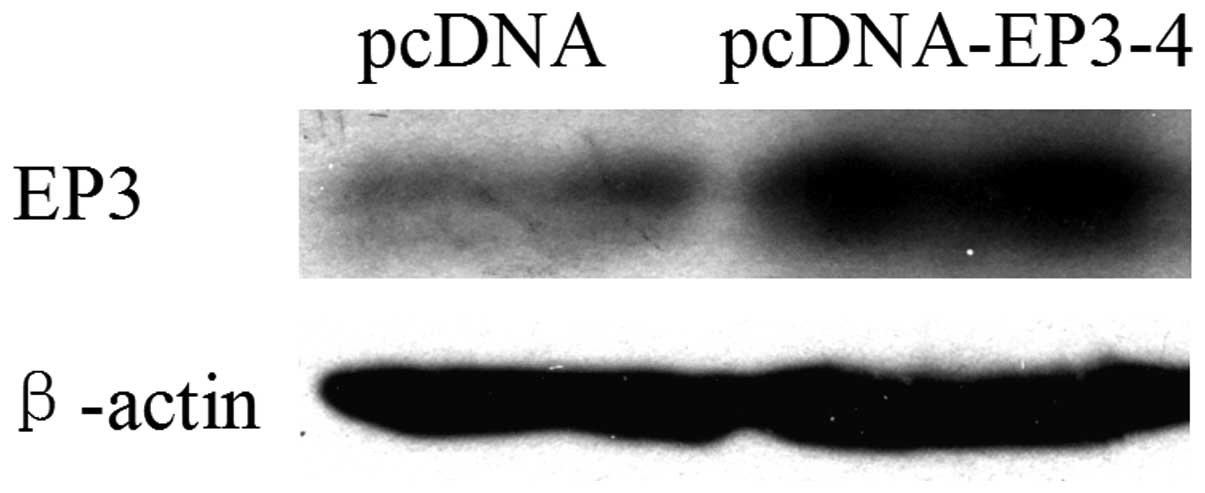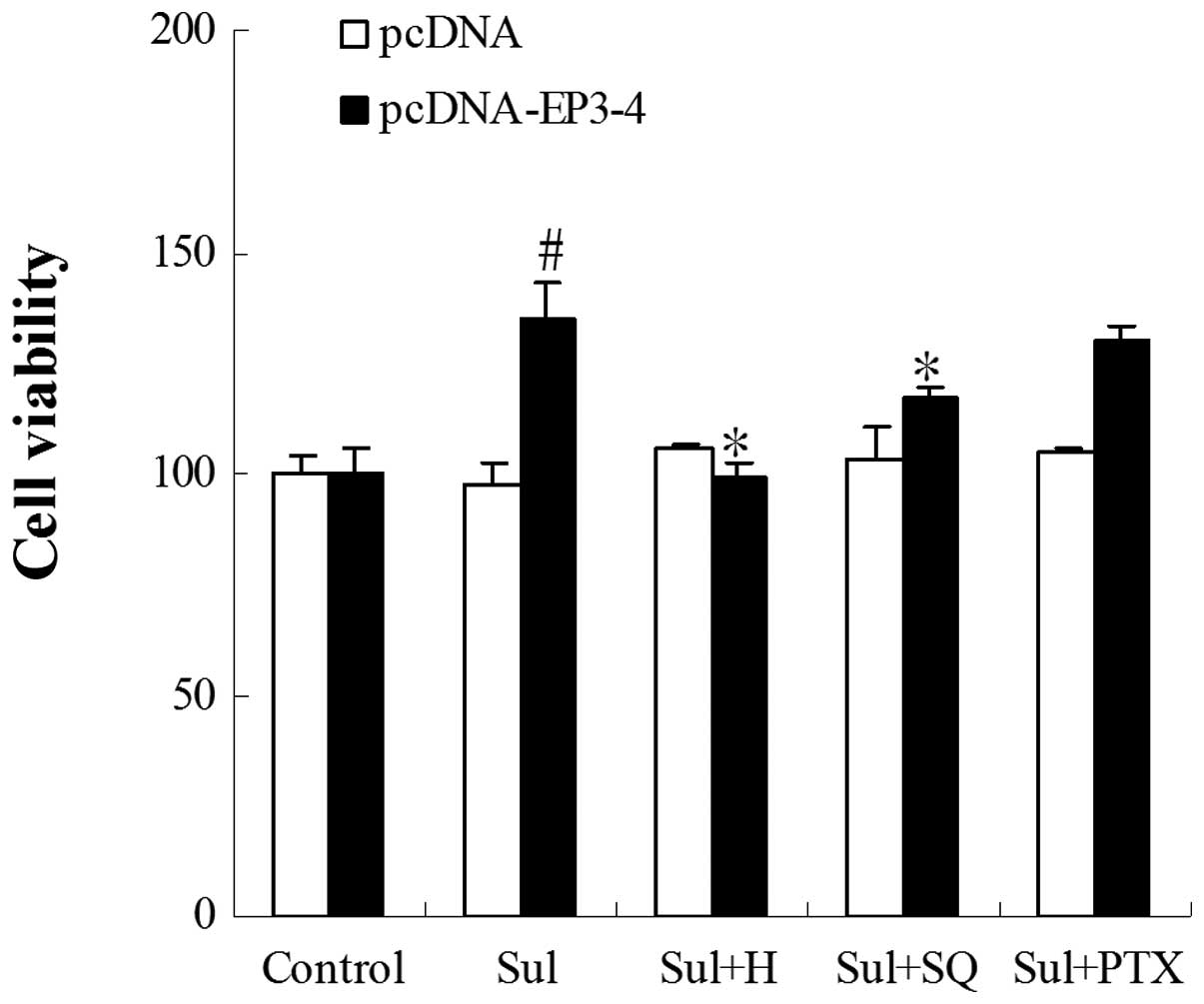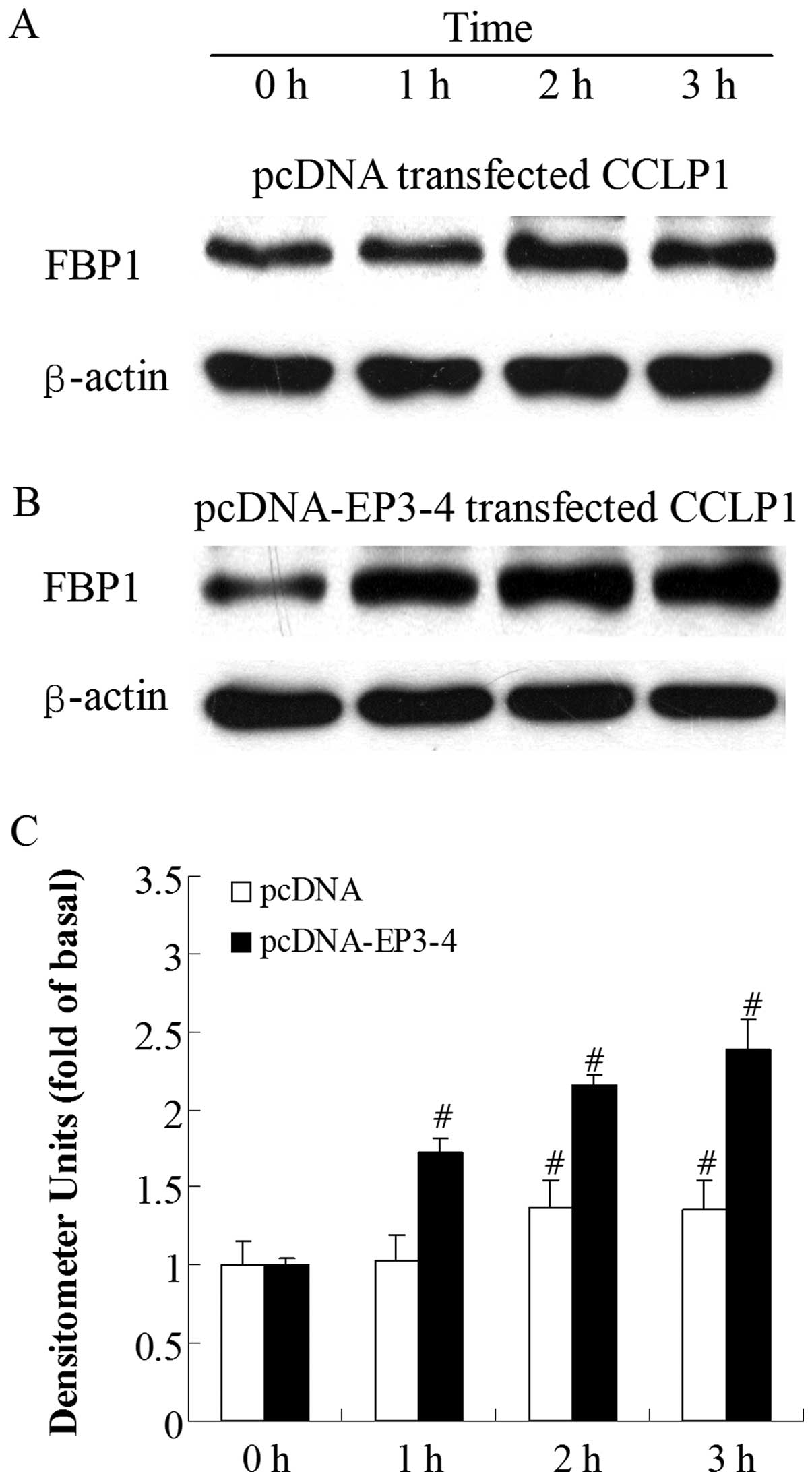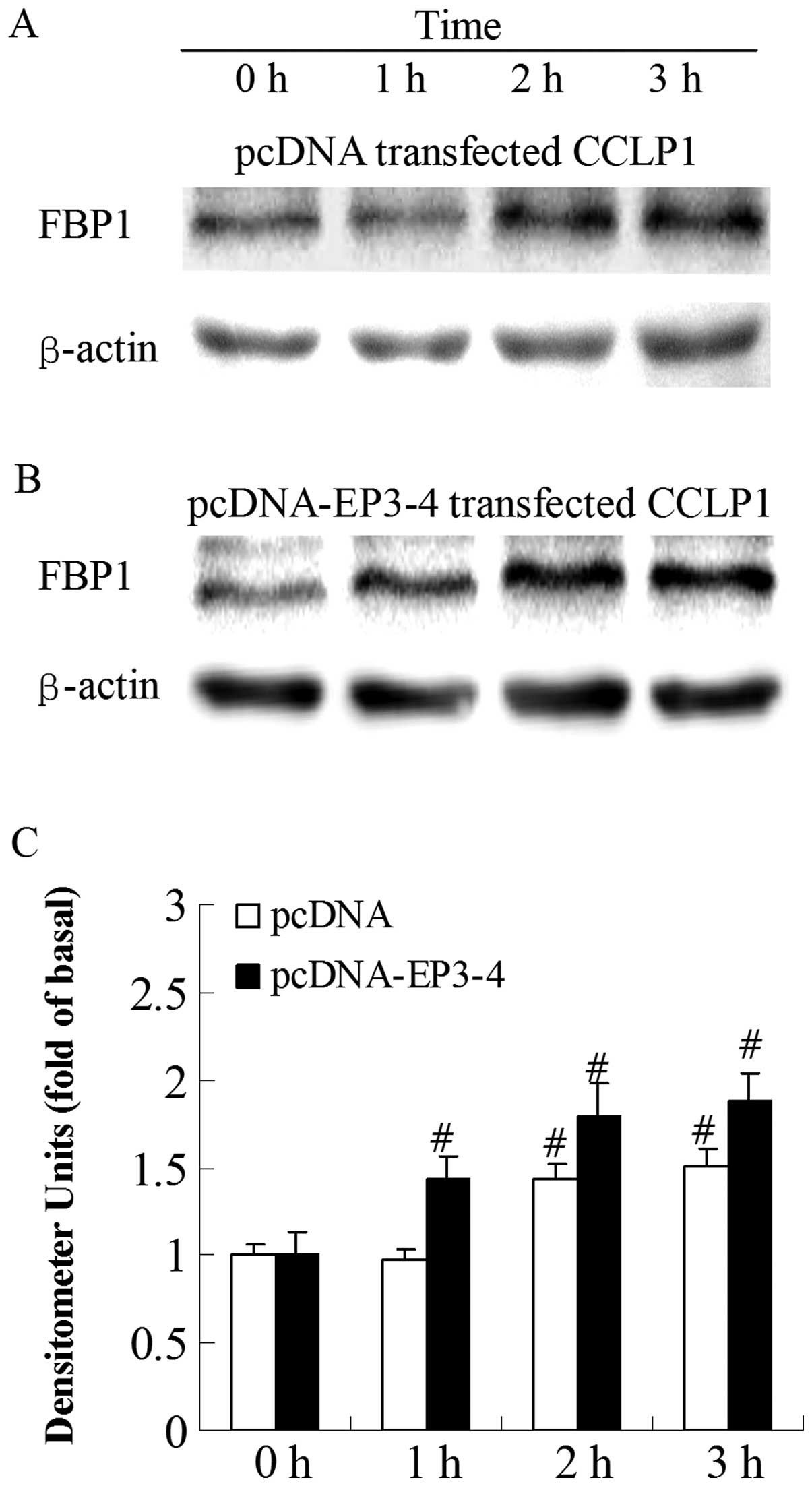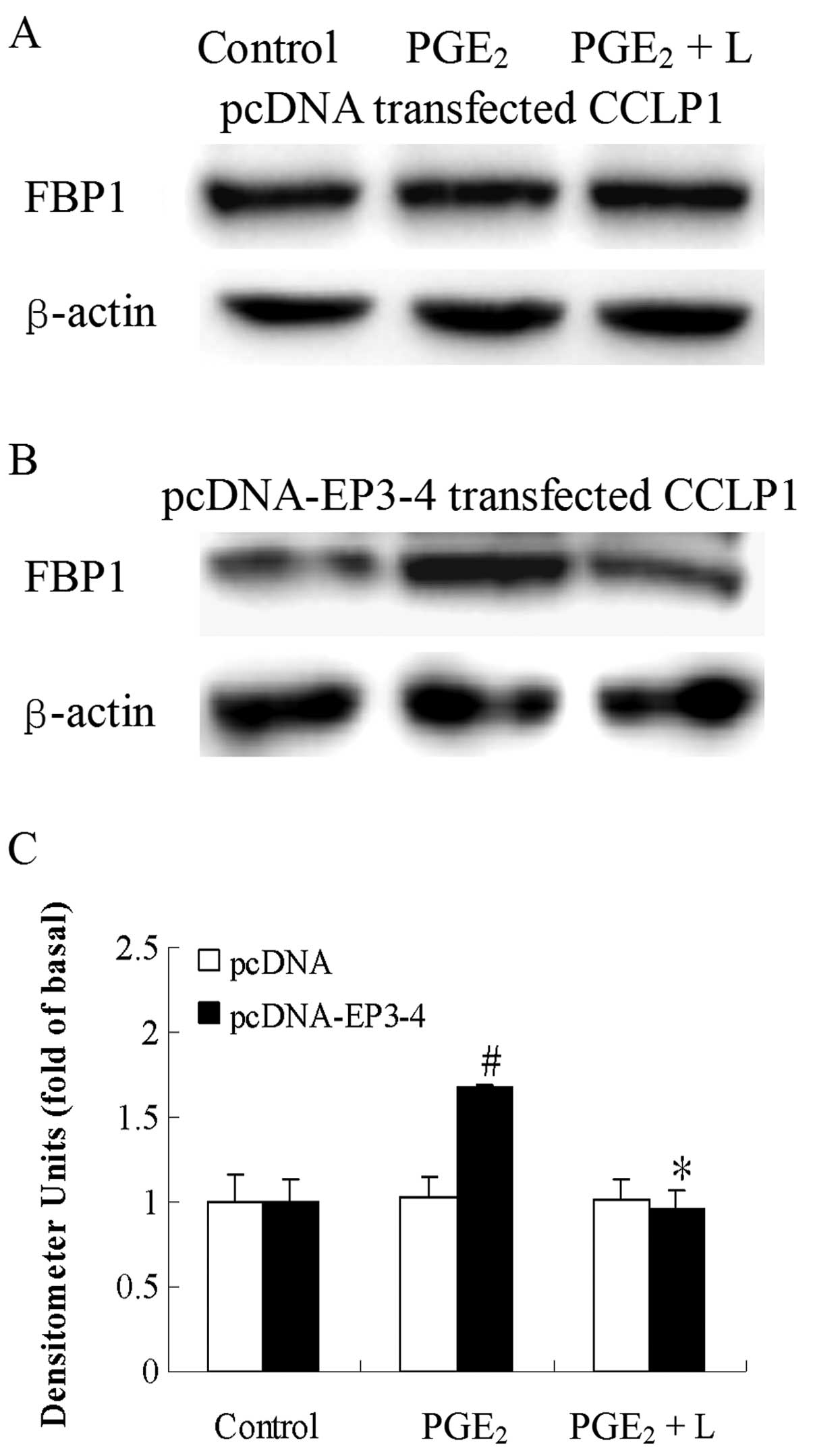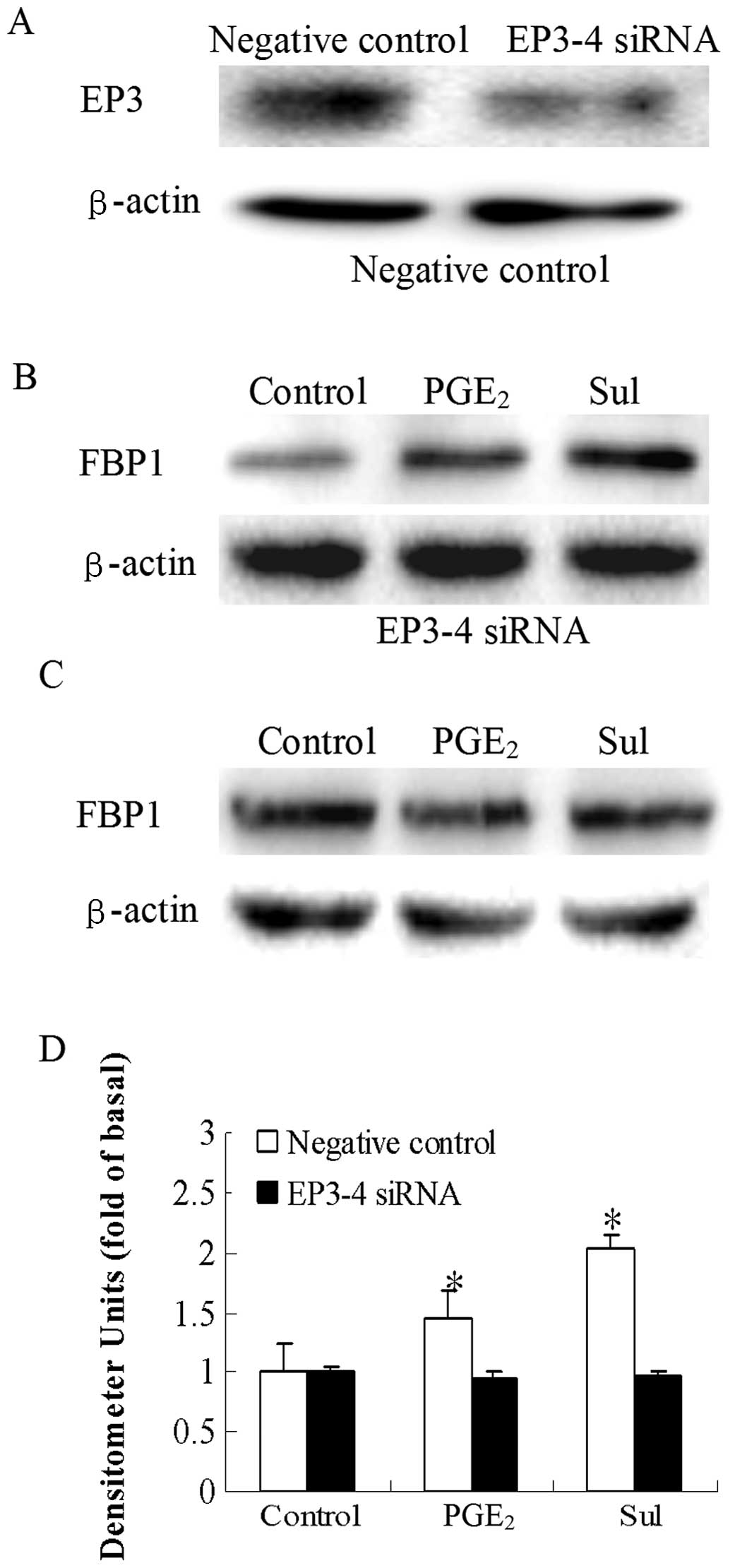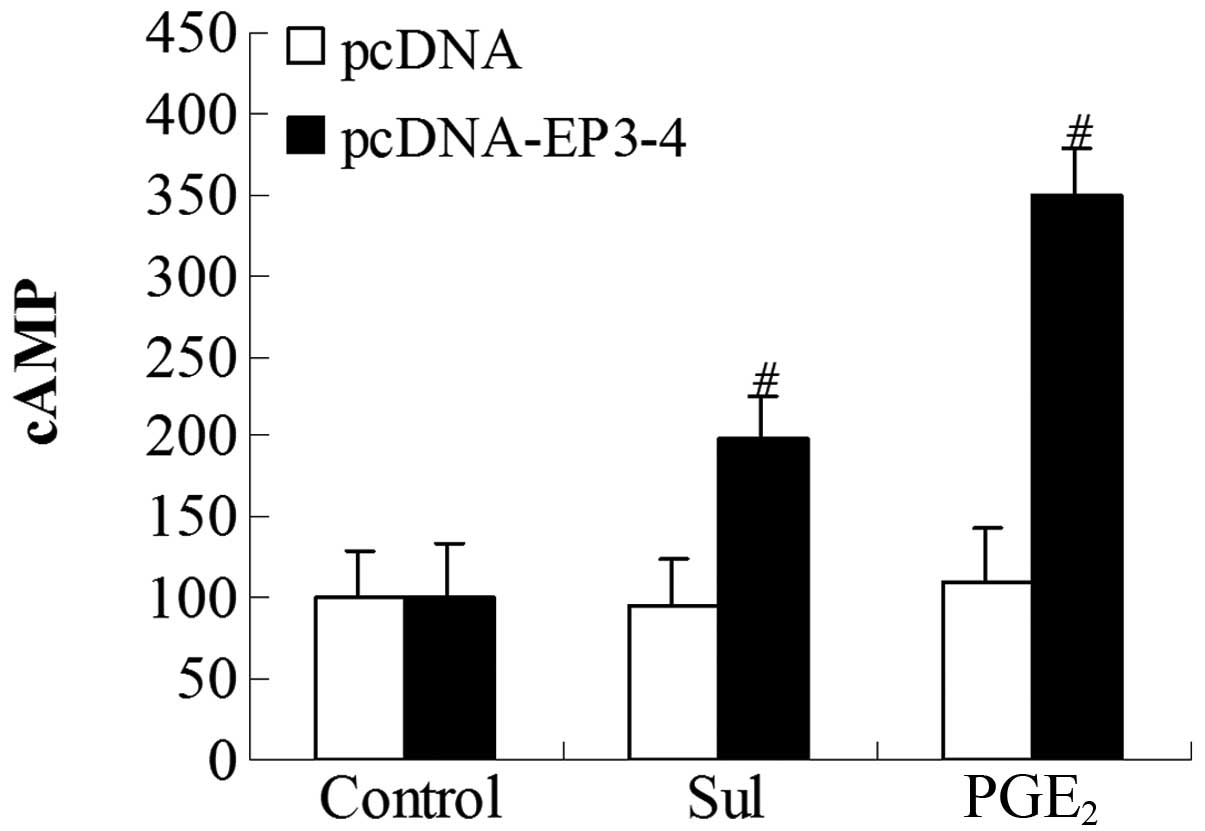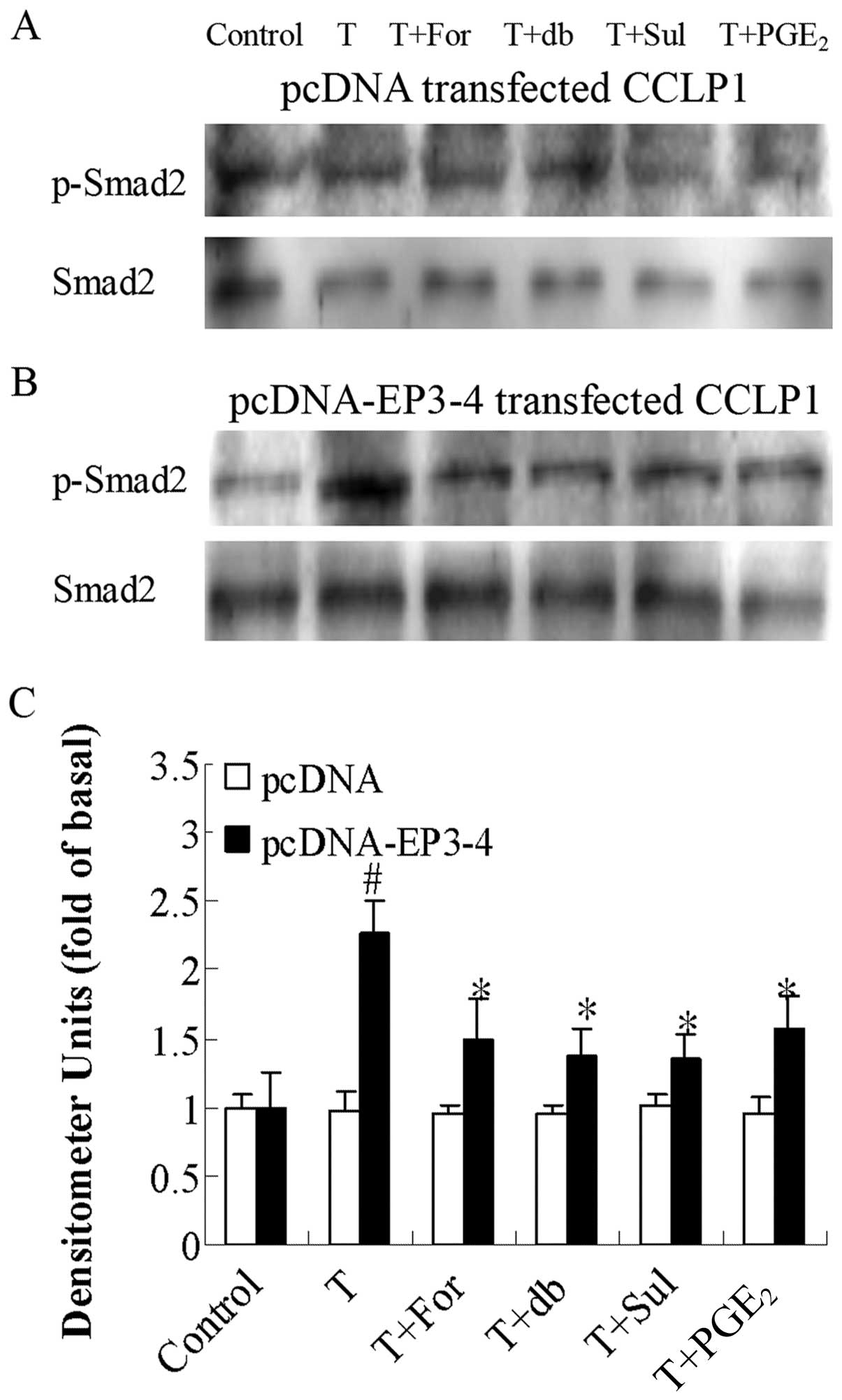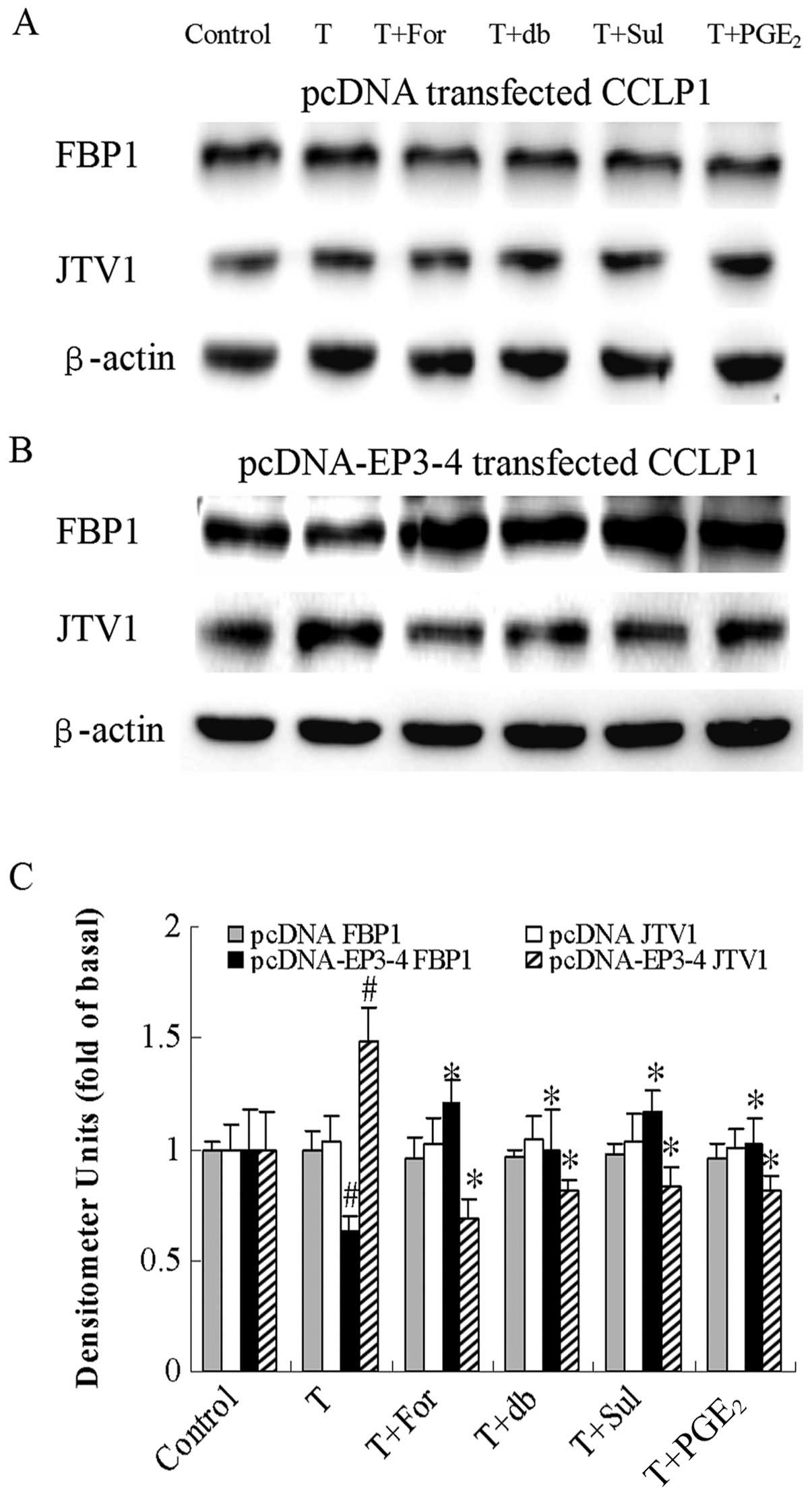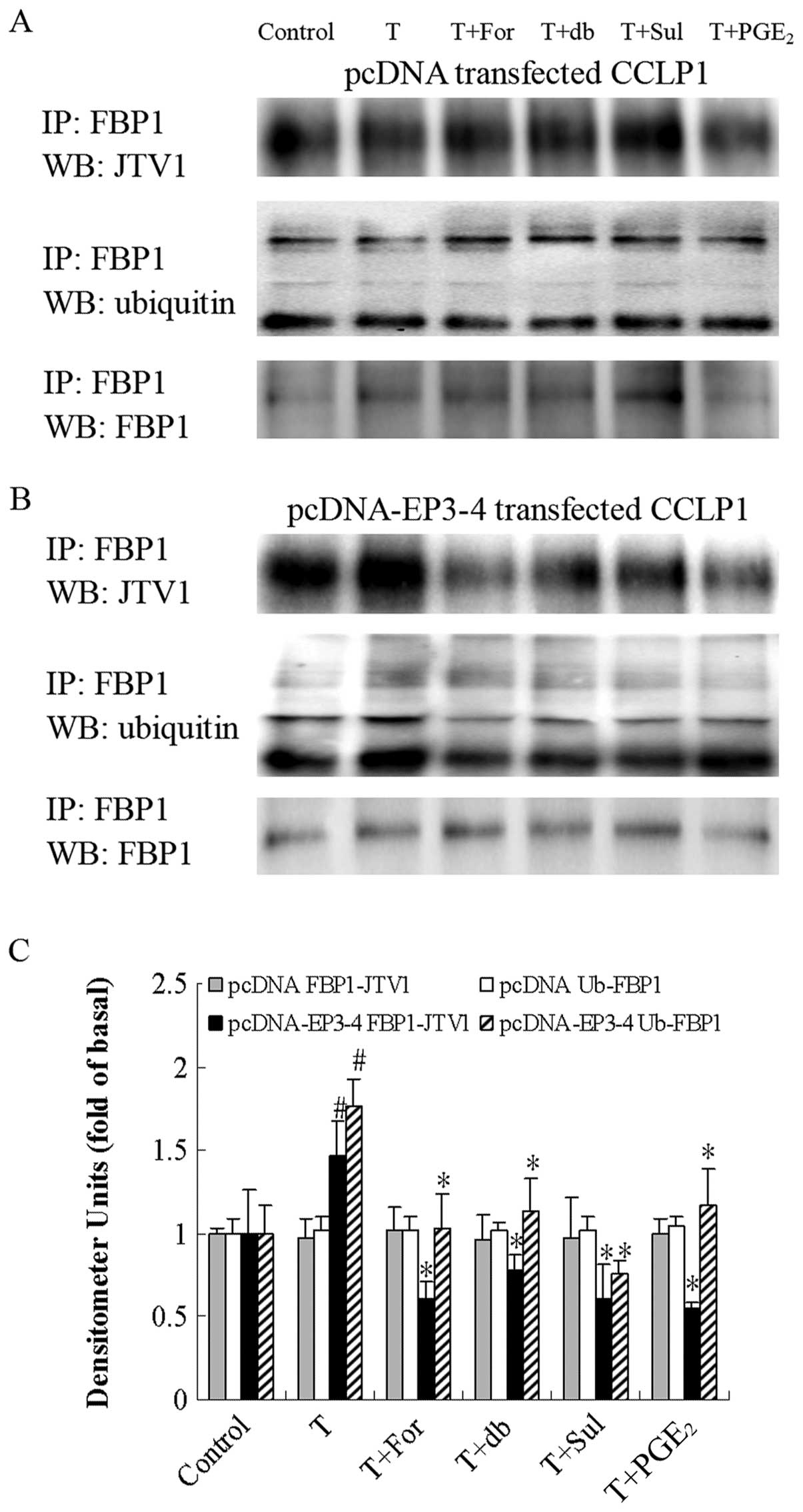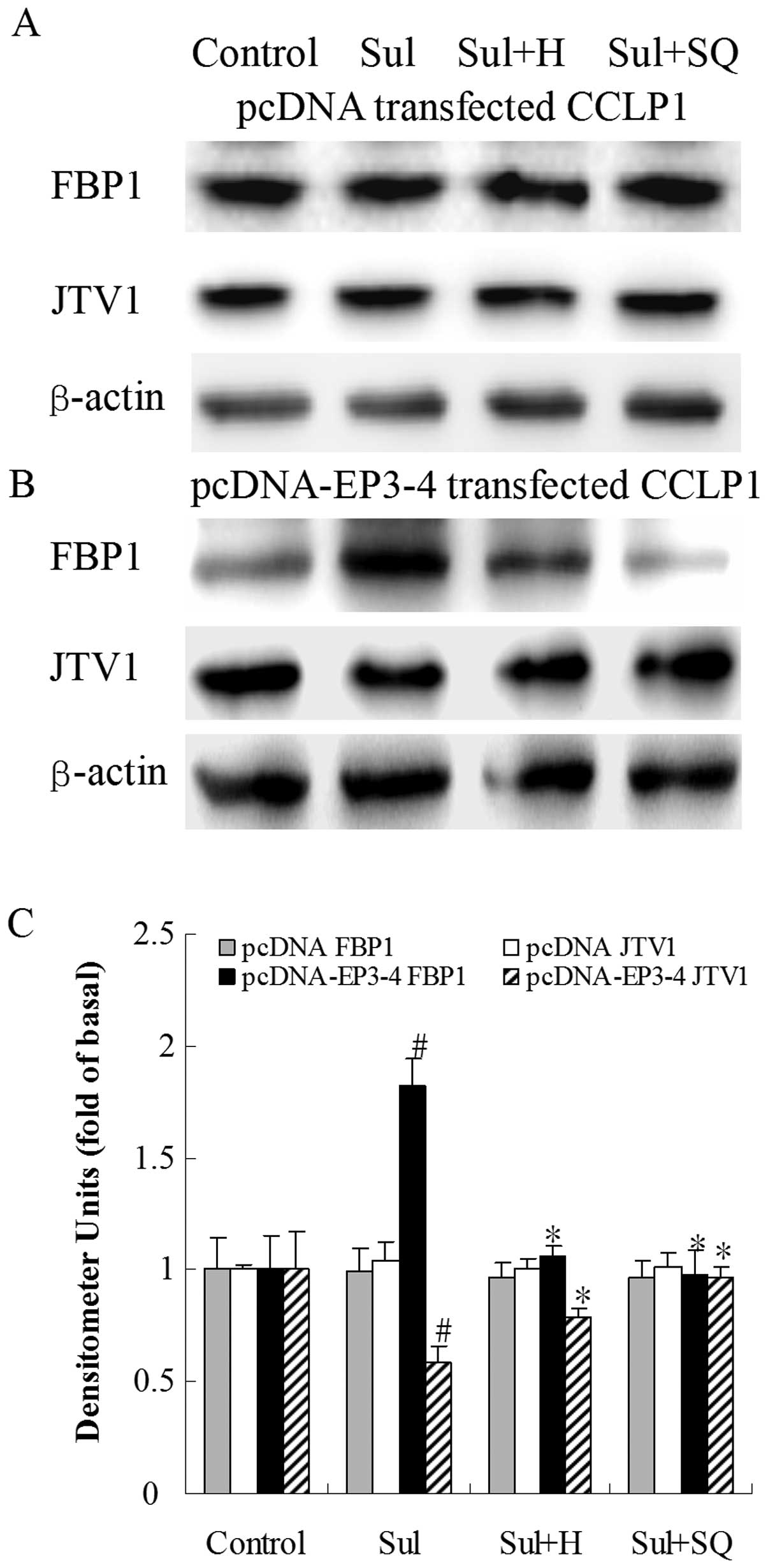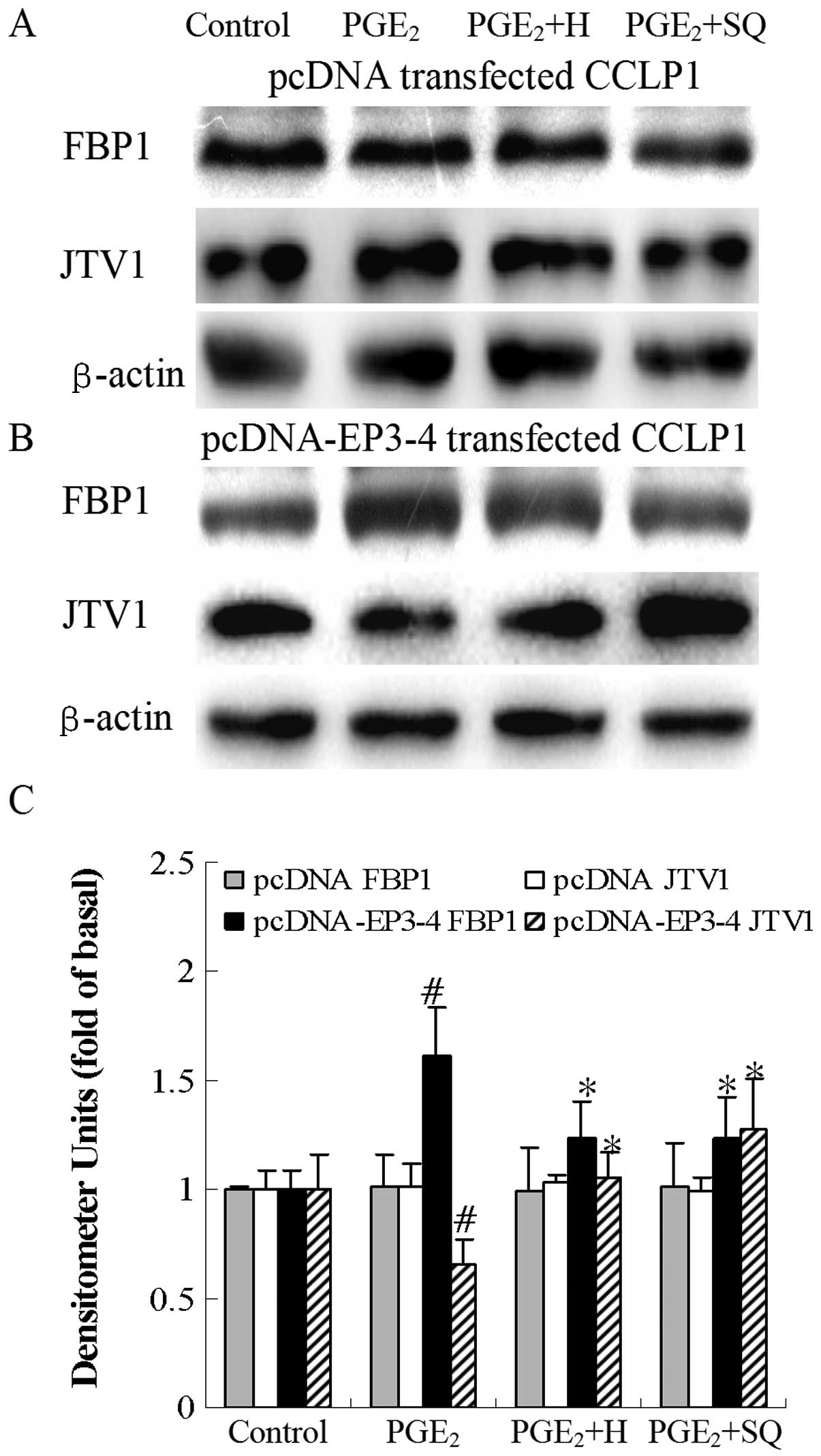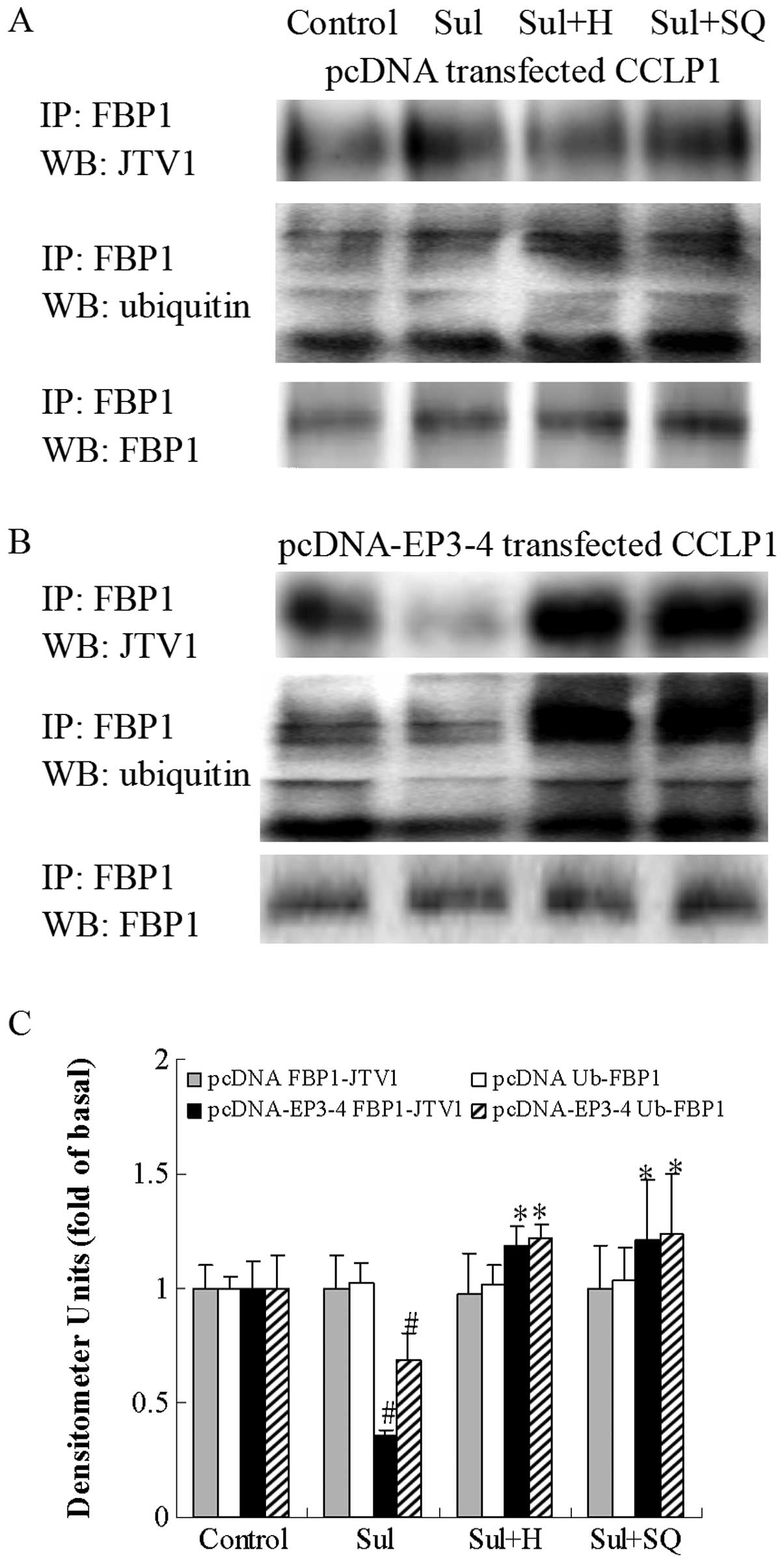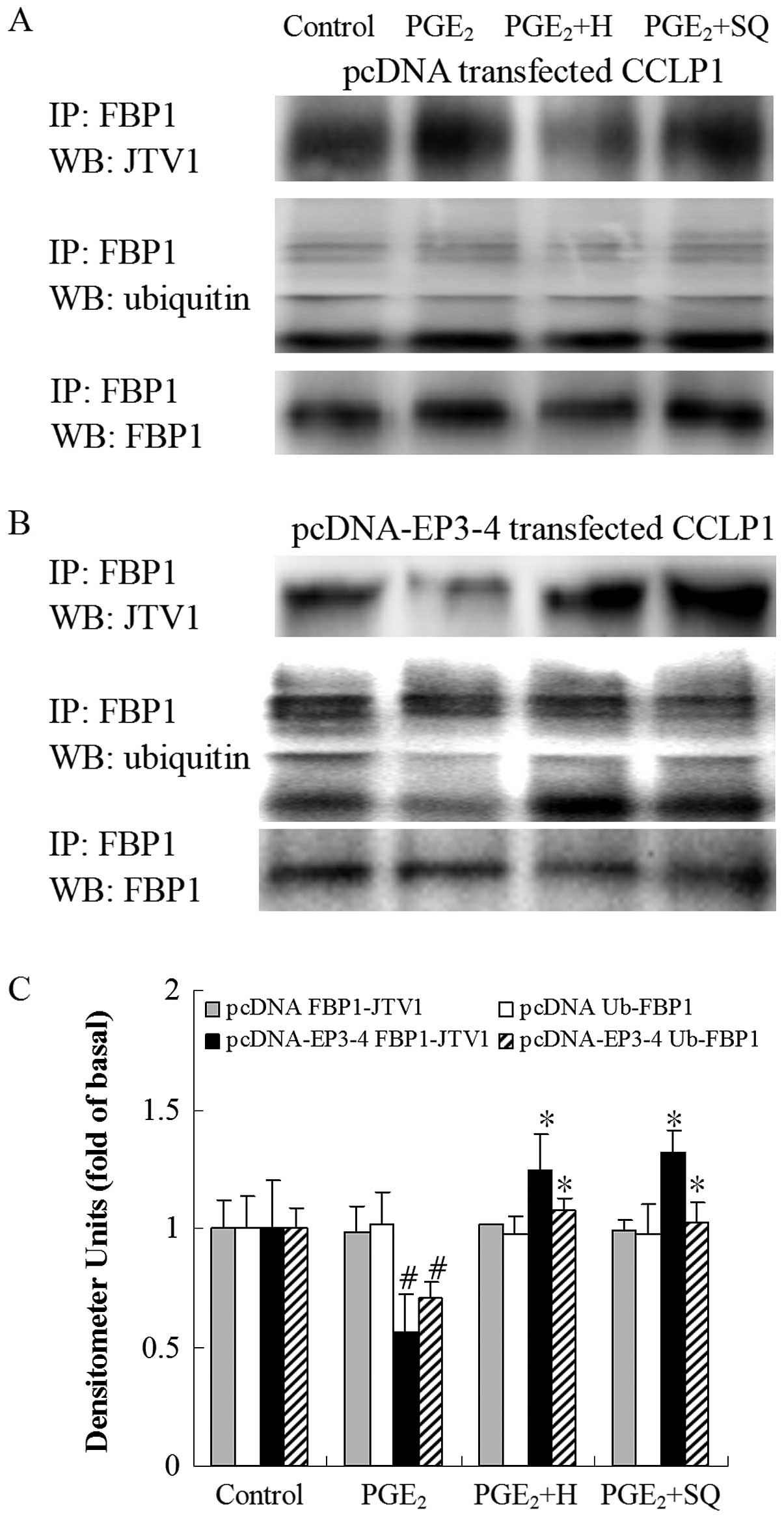Prostaglandin E2 promotes liver cancer cell growth by the upregulation of FUSE-binding protein 1 expression
- Authors:
- Published online on: January 18, 2013 https://doi.org/10.3892/ijo.2013.1782
- Pages: 1093-1104
Abstract
Introduction
Recent studies have shown that mediators of inflammation, such as prostaglandins (PGs), play an important role in tumorigenesis (1,2). Cyclooxygenase-2 (COX-2) is the key enzyme involved, as it triggers PG synthesis. The increased expression of COX-2 and the production of PGs are involved in the genesis of various human cancers, including carcinoma of the liver, colon, stomach, breast and lung (3–7). The knockdown of COX-2 gene expression suppresses skin carcinogenesis (8), and the targeted expression of COX-2 promotes colon cancer cell growth (9) and enhances skin tumorigenesis (8). Accumulating evidence has indicated that prostaglandin E2 (PGE2) promotes liver cancer cell growth (10,11); however, the exact mechanisms through which PGE2 regulates liver cancer development are currently unknown.
PGE2 signaling stimulates its G-protein-coupled plasma membrane receptors [E prostanoid (EP)1–4], which activate multiple signal transduction pathways leading to downstream responses. The EP1 receptor mainly couples to Gq protein and upregulates the level of intracellular Ca2+; EP2 and EP4 receptors couple to Gs protein, activate adenylate cyclase (AC) and increase the production of intracellular cyclic AMP (cAMP); however, the EP3 receptor couples to Gi protein, inactivates AC and decreases the formation of intracellular cAMP (12). Thus, the specific target of PGE2 in regulating cancer cell growth through EP receptors has not yet been well illustrated.
The EP3 receptor has multiple isoforms generated through alternative mRNA splicing in the carboxyl tail of the EP3 receptor gene. Thus far, 11 mRNA splice variants of the human EP3 receptor have been identified (13–15). Evidence of different signal transduction pathways and the regulation of gene expression among different EP3 receptor isoforms has also been demonstrated in a number of studies (16–18).
The FUSE-binding proteins (FBPs) are a family of 3 regulatory proteins, termed FBP1, FBP2 and FBP3 (19). FBP1 was initially characterized as a protein targeting the far upstream element, a positive cis-element of the human c-myc gene (19). In liver, renal and cervix carcinoma cell lines, FBP1 plays a role in tumorigenesis by regulating c-myc transcript and protein levels (19–22). FBP1 knockdown suppresses cell proliferation (20,23), increases sensitivity to apoptotic stimuli (23) and affects the maintenance of morphology in human hepatocellular carcinoma cells (20). Consistent with these observations, FBP1 knockdown has been shown to impair liver tumor formation in a mouse xenograft transplantation model (23). The overexpression of FBP1 promotes the proliferation of liver cancer cells (20,22,24). FBP1 overexpression significantly correlates with the proliferation and motility of human non-small cell lung cancer cells (25). Thus, FBP1 plays a role in malignant cell transformation. These findings strongly suggest the importance of FBP1 in the development and progression of human cancers.
Our previous studies demonstrated that EP3 receptor agonist upregulated FBP1 protein expression and promoted the proliferation of liver cancer cells (unpublished data). Thus, we hypothesized that PGE2 may promote liver cancer cell growth through the upregulation of FBP1 expression via the EP3 receptor pathway; the molecular mechanisms involved have not yet been reported.
Our present results revealed that EP3 receptor activated by PGE2 couples to Gs protein and activates cAMP-protein kinase A (PKA), downregulating the level of JTV1 protein, consequently inhibiting the ubiquitination of FBP1 and increasing FBP1 protein expression, thus promoting liver cancer cell growth.
Materials and methods
Antibodies and reagents
PGE2, the EP3 receptor agonist, sulprostone, and the Cyclic AMP EIA kit were purchased from Cayman Chemical Co. (Ann Arbor, MI, USA). The cell proliferation assay reagent, WST-1, was purchased from Dojindo Laboratories (Kumamoto, Japan). The human transforming growth factor-β1 (TGF-β1) was purchased from R&D Systems (Minneapolis, MN, USA). The EP3 receptor selective antagonist, L-798106, the PKA inhibitor, H89, the AC inhibitor, SQ22536, the cAMP analog, db-cAMP, and the Gi inhibitor, pertussis toxin (PTX), were obtained from Sigma-Aldrich (St. Louis, MO, USA). Lipofectamine™ 2000 and siRNA were purchased from Invitrogen (Carlsbad, CA, USA). Anti-EP3 (AV34104) and anti-β-actin antibodies were obtained from Sigma-Aldrich. Anti-FBP1 antibody (sc-11098) and protein A/G (sc-2003) were purchased from Santa Cruz Biotechnology (Santa Cruz, CA, USA). Anti-JTV1 antibody (10424-1-AP) was purchased from Proteintech (Chicago, IL, USA). Anti-ubiquitin antibody (ab19247) was purchased from Abcam (Cambridge, UK). Anti-p-Smad2 (BS4172) and anti-Smad2 (BS1425) antibodies were obtained from Bioworld Technology Inc. (St. Louis Park, MN, USA).
Cell lines and culture
CCLP1 human liver cancer cells from the Department of Transplantation Pathology, University of Pittsburgh Medical Center (UPMC; Pittsburgh, PA, USA) were cultured in Dulbecco’s modified Eagle’s medium (DMEM), supplemented with 10% FBS, 2 mM L-glutamine, and 50 μg/ml gentamicin at 37°C in 5% CO2.
Cell proliferation
Cell growth was determined using the cell proliferation reagent, WST-1, a tetrazolium salt that is cleaved by mitochondrial dehydrogenases in viable cells. Briefly, 100 μl of cell suspension (containing 0.5–2×104 cells) were plated in each well of 96-well plates. Cells were cultured overnight. The cells were then incubated with different treatments at the indicated concentrations and time periods. Cell proliferation reagent, WST-1 (10 μl), was subsequently added to each well. The incubation was continued from 30 min to 4 h at 37°C, and absorbance at 450 nm was measured using an automatic ELISA plate reader.
Overexpression of EP3-4 plasmid in CCLP1 cells
The CCLP1 cells were exposed to the mixture of Lipofectamine 2000 and EP3-4 plasmid or pcDNA3.1 control vector for 4 h. Following the removal of the transfection mixtures, fresh DMEM with 10% fetal bovine serum was added. On the second day, the medium was changed, and the cells were incubated with medium containing 300 μg/ml G418 sulfate. Subsequent cultures of selected CCLP1 cells were routinely grown in the presence of selective pressure. Western blot analysis was performed in the selected cells permanently transfected with EP3-4 or control plasmids. The selected cells with the successful increase in EP3-4 expression were subsequently used for further experiments.
RNA interference
Cells were transfected with either EP3-4 siRNA or with the negative RNA duplex as the control using Lipofectamine 2000. The depletion of EP3-4 was confirmed by western blot analysis.
Preparation of whole cell lysate
At the end of each treatment, cellular extracts were prepared in radio immunoprecipitation assay (RIPA) buffer consisting of 50 mM Tris (pH 7.4), 150 mM NaCl, 1% NP-40, 0.25% sodium deoxycholate, in the presence of protease inhibitors and phosphatase inhibitors as follows: 2 mM sodium pyrophosphate, 1 mM sodium orthovanadate, 1 mM sodium fluoride, 1 mM EDTA, 0.5 μg/ml leupeptin and 1 mM phenyl-methylsulfonyl fluoride (PMSF). After sonication, the whole cell lysate was collected by centrifugation at 10,000 rpm at 4°C for 10 min using a microcentrifuge to remove cell debris. The samples were stored at −80°C until use. The protein concentrations in the cell extracts were determined by the Bio-Rad protein assay.
Western blot analysis
Equal amounts of protein (20 μg) or protein purified by immunoprecipitation were separated by 12% SDS-PAGE and electrotransferred onto nitrocellulose membranes for western blot analysis. Membranes were blocked with 5% defatted milk in TBST (10 mM Tris, pH 7.4, 0.1% Tween-20, and 100 mM NaCl) for 1 h at room temperature. Blotted proteins were probed with the primary antibodies overnight at 4°C in TBST containing 1% defatted milk. The membranes were then washed and incubated with horseradish peroxidase-conjugated secondary antibodies in TBST for 1 h. Signals were generated by enhanced chemiluminescent reagent (ECL, Amersham) according to the manufacturer’s instructions and visualized by exposing with the Bio-Rad system. Quantification was performed using ImageJ software. The results are expressed as the fold change vs. the control.
Immunoprecipitation
Cellular extracts (100 μg protein) were incubated overnight at 4°C in RIPA buffer with antibody against FBP1 (2 μg). Protein A/G-agarose beads were then added. The mixture was gently vortexed and incubated for 2 h at 4°C. The beads were recovered by centrifugation at 10,000 × g and gently washed 3 times with RIPA buffer. SDS sample loading buffer for SDS-PAGE was added, and the mixture was incubated at 100°C for 5 min. The beads were centrifugated, and the supernatants were applied to 12% SDS-PAGE.
cAMP production
To measure cAMP production, the cells cultured in 6-well plates were serum-starved overnight. The cells were exposed to sulprostone, PGE2 and the vehicle. After a 10-min incubation, the cells were collected and resuspended in 0.1 M HCl, then a 50-μl centrifuged sample was analyzed for cAMP production according to the manufacturer’s instructions.
Statistical analysis
The values are expressed as the means ± SD. Data were analyzed by one-way analysis of variance followed by the Student’s t-test. A value of p<0.05 was considered to indicate a statistically significant difference.
Results
Effect of EP3-4 receptor overexpression in CCLP1 cells
As shown in Fig. 1, CCLP1 cells were stably transfected with the EP3-4 expression plasmid or the pcDNA3.1 control plasmid. The western blot analysis results showed that the EP3-4 receptor was overexpressed in the EP3-4-pcDNA3.1-transfected CCLP1 cells.
Effect of EP3 receptor activation on the growth of CCLP1 cells
The EP3-4- and control plasmid pcDNA3.1-transfected CCLP1 cells were examined for their response to treatment with the EP3 agonist, sulprostone. To determine the proliferation of the cells, the cells were treated with 10 μM of EP3 receptor agonist (sulprostone), 10 μM PKA inhibitor (H89), 50 μM AC inhibitor (SQ22536) and 50 nm Gi subunit inhibitor (PTX) (Fig. 2). The treatment of EP3-4-transfected CCLP1 cells with sulprostone for 24 h induced a 35.17% increase in cell growth. The treatment of these cells with sulprostone + H89 and sulprostone + SQ22536, dereased the growth rate by 26.5 and 13.5% compared to treatment with sulprostone alone. However, PTX had no effect on the cell growth induced by sulprostone. The empty pcDNA3.1-transfected cells showed no response.
Sulprostone and PGE2 induce an increase in FBP1 protein expression in CCLP1 cells
To investigate which molecule was regulated by PGE2 viathe EP3 receptor, we examined the effects of the EP3 receptor agonist, sulprostone, and PGE2 on the level of FBP1 protein. By contrast, at the 1-h time-point, the treatment of the empty pcDNA3.1-transfected cells with 10 μM sulprostone had no effect on FBP1 protein levels and the increase in FBP1 protein expression was only observed at 2 h (Fig. 3A). Fig. 3B shows that the treatment of the EP3-4-transfected cells with 10 μM sulprostone induced an increase in FBP1 levels in a time-dependent manner. The level of FBP1 protein was rapidly increased within 1 h (1.72-fold increase compared to 0 h). A similar pattern of increased FBP1 protein expression was observed when the cells were treated with 10 μM PGE2, with a 1.43-fold increase at 1 h compared to 0 h in the EP3-4-transfected cells (Fig. 4B). PGE2 had no effect on the FBP1 protein at 1 h in the empty pcDNA3.1-transfected cells (Fig. 4A).
Effects of blocking EP3 receptor on PGE2-induced increase in FBP1 protein expression in CCLP1 cells
We then examined the direct effects of the EP3 receptor antagonist, L-798106, and EP3-4 siRNA on the PGE2-induced increase in FBP1 protein expression. In the EP3-4-transfected cells, treatment with 10 μM PGE2 and 10 μM L-798106 resulted in a 43% decrease in FBP1 protein expression induced by PGE2 (Fig. 5B). L-798106 had no effect on the empty pcDNA3.1-transfected cells (Fig. 5A). Consistent with these results, the PGE2 and sulprostone-induced increase in FBP1 protein expression was also blocked by the siRNA suppression of the EP3-4 receptor in the EP3-4-transfected cells (Fig. 6C). In the negative siRNA-transfected cells, the levels of FBP1 protein in the PGE2 and sulprostone groups were 1.46- and 2.02-fold higher compared to those in the the control group (Fig. 6B). The effect of the siRNA suppression of the EP3-4 receptor in the EP3-4-transfected cells was detected by western blot analysis (Fig. 6A). These findings demonstrate the key role of the EP3 receptor in the regulation of FBP1 protein expression by PGE2.
Effects of EP3 receptor activation on the cytoplasmic cAMP production in CCLP1 cells
To further investigate whether the EP3 receptor couples to the Gs subunit, we examined the cytoplasmic cAMP production induced by PGE2 and sulprostone. The EP3-4-transfected cells and the empty pcDNA3.1-transfected cells were treated with 10 μM PGE2 and 10 μM sulprostone. In the EP3-4-transfected cells, the levels of cAMP induced by PGE2 and sulprostone were relatively increased by 248.56 and 99.42%, respectively. PGE2 and sulprostone had no effect on the empty pcDNA3.1-transfected cells (Fig. 7).
Effects of the AC activator, forskolin, cAMP analog, db-cAMP, EP3 agonist, sulprostone, and PGE2 on PKA inhibitor H89-induced Smad2 phosphorylation in CCLP1 cells
Since PKA downregulates TGF-β activity, we examined the effects of the AC activator, forskolin, the cAMP analog, db-cAMP, the EP3 agonist, sulprostone, and PGE2 on PKA inhibitor H89-induced Smad2 phosphorylation. Fig. 8B shows that in the EP3-4-transfected cells, 10 μM H89 treatment induced the rapid phosphorylation of Smad2 (1.49-fold compared to the control). In addition, treatment with 10 μM forskolin, 100 μM db-cAMP, 10 μM sulprostone and 10 μM PGE2 reduced the Smad2 phosphorylation induced by H89 by 49, 26, 32 and 38%, respectively. As shown in Fig. 8A, these reagents had no effect on the empty pcDNA3.1-transfected cells.
Effects of the AC activator, forskolin, cAMP analog, db-cAMP, EP3 agonist, sulprostone, and PGE2 on TGF-β1-induced Smad2 phosphorylation in CCLP1 cells
To further document that PGE2-EP3-Gs-PKA inhibits TGF-β activity, we examined the effects of the AC activator ,forskolin, the cAMP analog, db-cAMP, the EP3 agonist, sulprostone, and PGE2 on TGF-β1-induced Smad2 phosphorylation. Fig. 9B shows that in the EP3-4-transfected cells, treatment with 2 ng/ml TGF-β1 induced an increase in the phosphorylation of Smad2 (2.26-fold compared to the control). In addition, treatment with forskolin, db-cAMP, sulprostone and PGE2 reduced the Smad2 phosphorylation induced by TGF-β1 by 24, 40, 40 and 30%, respectively. As shown in Fig. 9A, these reagents had no effect on the empty pcDNA3.1-transfected cells.
Effects of the AC activator, forskolin, cAMP analog, db-cAMP, EP3 agonist, sulprostone, and PGE2 on TGF-β1-induced FBP1 and JTV1 protein expression in CCLP1 cells
We then examined the effects of the AC activator, forskolin, the cAMP analog, db-cAMP, the EP3 agonist, sulprostone, and PGE2 on TGF-β1-induced FBP1 and JTV1 protein expression. Fig. 10B shows that in the EP3-4-transfected cells, the level of FBP1 protein induced by TGF-β1 was decreased by 37% of the control. The levels of FBP1 protein in the TGF-β1 + forskolin, TGF-β1 + db-cAMP, TGF-β1 + sulprostone and TGF-β1 + PGE2 groups were decreased by 1.90-, 1.56-, 1.84-and 1.62-fold, respectively compared to the TGF-β1 group. The level of JTV1 protein induced by TGF-β1 was 1.48-fold of the control. The levels of JTV1 protein in the TGF-β1 + forskolin, TGF-β1 + db-cAMP, TGF-β1 + sulprostone and TGF-β1 + PGE2 groups were decreased by 54, 45, 44 and 45%, respectively compared to the TGF-β1 group. As shown in Fig. 10A, these reagents had no effect on the empty pcDNA3.1-transfected cells. These results indicate that the PGE2-EP3-Gs-PKA inhibition of TGF-β1 regulates the protein expression of FBP1 and JTV1.
Effects of the AC activator, forskolin, cAMP analog, db-cAMP, EP3 agonist, sulprostone, and PGE2 on TGF-β1-induced binding of JTV1 with FBP1 and the ubiquitination of FBP1 in CCLP1 cells
As shown in Fig. 11B, in the EP3-4-transfected cells, TGF-β1 treatment induced the binding of JTV1 with FBP1 (1.47-fold of the control) and the ubiquitination of FBP1 (1.76-fold of the control). In addition, the binding of FBP1 with JTV1 in the TGF-β1 + forskolin, TGF-β1 + db-cAMP, TGF-β1 + sulprostone and TGF-β1 + PGE2 groups was deceased by 59, 48, 59 and 63%, respectively compared to the TGF-β1 group. The ubiquitination of FBP1 in the TGF-β1 + forskolin, TGF-β1 + db-cAMP, TGF-β1 + sulprostone and TGF-β1 + PGE2 groups was deceased by 41, 36, 57 and 33%, respectively compared to the TGF-β1 group. As shown in Fig. 11A, these reagents had no effect on the empty pcDNA3.1-transfected cells.
Effects of the PKA inhibitor, H89, and AC inhibitor, SQ22536, on sulprostone and PGE2-induced FBP1 and JTV1 protein expression in CCLP1 cells
The findings presented above suggested that the activation of cAMP-PKA induced by PGE2 via the EP3 receptor suppressed TGF-β, regulating the binding of JTV1 with FBP1 and the ubiquitination of FBP1, and thus regulating FBP1 protein expression. To further evaluate this hypothesis, we examined whether the inhibition of cAMP-PKA would alter the levels of JTV1 and FBP1 protein induced by PGE2 via the EP3 receptor. The cells were treated with sulprostone and PGE2 in the presence or absence of the PKA inhibitor, H89, and the AC inhibitor, SQ22536, to determine the levels of JTV1 and FBP1 protein. As shown in Fig. 12B, in the EP3-4-transfected cells, sulprostone increased the FBP1 protein levels by 82% compared to the control. Treatment with H89 and SQ22536 followed by sulprostone decreased the FBP1 protein levels by 42 and 47%, respectively compared to treatment with sulprostone alone. Sulprostone decreased the JTV1 protein levels by 40% compared to the control. Treatment with H89 and SQ22536 followed by sulprostone increased the JTV1 protein levels by 36 and 66%, respectively compared to treatment with sulprostone alone. Consistent with these results, as shown in in Fig. 13B, in the EP3-4-transfected cells, PGE2 increased the FBP1 protein levels by 73% compared to the control. Treatment with H89 and SQ22536 followed by PGE2 decreased the FBP1 protein levels by 22 and 27%, respectively compared to treatment with sulprostone alone. PGE2 decreased the JTV1 protein levels by 20% compared to the control. Treatment with H89 and SQ22536 followed by PGE2 increased the JTV1 protein levels by 61 and 94%, respectively compared to treatment with PGE2 alone. H89 and SQ22536 had no effect on the empty pcDNA3.1-transfected cells (Figs. 12A and 13A).
Effects of the PKA inhibitor, H89, and AC inhibitor, SQ22536, on the sulprostone and PGE2-mediated binding of JTV1 with FBP1 and the ubiquitination of FBP1 in CCLP1 cells
The cells were treated with sulprostone and PGE2 in the presence or absence of the PKA inhibitor, H89, and the AC inhibitor, SQ22536, to determine the binding of JTV1 with FBP1 and the ubiquitination of FBP1. As shown in Fig. 14B, in the EP3-4-transfected cells, sulprostone decreased the binding of JTV1 with FBP1 by 64% compared to the control. The binding of JTV1 with FBP1 following treatment with H89 and SQ22536 followed by sulprostone was increased by 3.31-and 3.39-fold, respectively compared to treatment with sulprostone. Sulprostone decreased the ubiquitination of FBP1 by 31% compared to the control. The ubiquitination of FBP1 following treatment with H89 and SQ22536 followed by sulprostone was increased by 1.77- and 1.79-fold, respectively compared to treatment with sulprostone. Consistent with these results, as in shown in Fig. 15B, PGE2 decreased the binding of JTV1 with FBP1 by 44% compared to the control. The binding of JTV1 with FBP1 following treatment with H89 and SQ22536 followed by PGE2 was increased by 2.21- and 2.34-fold, respectively compared to treatment with PGE2. PGE2 decreased the ubiquitination of FBP1 by 30% compared to the control. In the EP3-4-transfected cells, the ubiquitination of FBP1 following treatment with H89 and SQ22536 followed by PGE2 was increased by 1.53- and 1.46-fold, respectively compared to treatment with PGE2. H89 and SQ22536 had no effect on the empty pcDNA3.1-transfected cells (Figs. 14A and 15A).
Discussion
FBPs preferentially bind to single-stranded DNA and to RNA sequences, and are known to act as transcription factors, but have been postulated to regulate transcript stability (19). The FBPs are therefore likely to be multifunctional. FBP1, as the family progenitor, is involved in regulation of multiple physiological functions, such as gene expression and tissue differentiation (26–28). FBP1 binds through its 4 K-homology domains to FUSE of the c-myc promoter, leading to the upregulation of c-myc(29,30). Moreover, inhibition or loss of FBP1 function abrogates c-myc expression and arrests cellular proliferation (26,31). FBP1 is developmentally regulated in the mouse and chicken embryonic brain (32) and has been identified as a Parkin substrate (33). FBP1 is present in undifferentiated cells and is downregulated following differentiation (26,34,35). FBP1 is critical for cancer cell growth.
Our findings suggest that PGE2 and the EP3 receptor agonist, sulprostone, upregulate the level of FBP1 protein and promote liver cancer cell growth. The EP3 receptor inhibitor, L-798106, and EP3-4 siRNA suppressed the increased FBP1 protein expression induced by PGE2 and sulprostone. These results demonstrate that PGE2 upregulates FBP1 protein via the EP3 receptor. More significantly, this study provides important experimental evidence and mechanisms for PGE2/EP3/FBP1 signaling pathways in liver cancer cells.
According to previous reports, the EP3 receptor couples to the Gi subunit and decreases cytoplasmic cAMP (12). However, in this study, we showed that the Gi subunit inhibitor, PTX, exhibited no significant effect. By contrast, the inhibitor of the Gs subunit pathway suppressed the proliferation of liver cancer cells induced by EP3 receptor activation. Therefore, we hypothesized that the EP3 receptor might couple to the Gs subunit, not the Gi subunit. If the EP3 receptor couples to the Gs subunit, it may increase cytoplasmic cAMP production.
The observations that cytoplasmic cAMP was increased by PGE2 and the EP3 agonist support our hypothesis. These results indicate that the EP3 receptor may couple to the Gs subunit and upregulate cAMP, which is not consistent with previous data on the EP3 receptor. Moreover, studies supporting our results of the EP3 receptor clarify that the EP3 receptor couples to the Gs subunit, activates AC, increases cAMP, and promotes tumor growth, angiogenesis and metastasis (36–38). The G protein consists of α, β and γ subunits and is divided into Gs, Gi and Gq, etc. Different types of G proteins mediate various signaling pathways; the Gs protein activates AC, upregulates cAMP production and induces PKA activation; the Gi protein inactivates AC, downregulates cAMP production; and the Gq protein induces the increase in Ca2+ and the activation of PKC (12,39). In this study, the EP3 receptor activated by PGE2 coupled to the Gs protein, GDP of Gα subunit of Gs exchanged with GTP followed by the dissociation of Gα and Gβγ, leading to AC activation and an increased in cAMP production.
It has been indicated that cAMP activates PKA in adipose cells (40). Our data showed that the PKA inhibitor, H89, and the AC inhibitor, SQ22536, suppressed the increase in FBP1 protein expression, as well as the decrease in JTV1 protein expression, blocked the suppression of the binding of JTV1 with FBP1 and the decreased ubiquitination of FBP1 induced by PGE2 and sulprostone, which demonstrates that cAMP-PKA is involved in the signaling pathway mediated by the EP3 receptor.
The activation of PKA has been shown to decrease TGF-β activity in osteoblasts (41). TGF-βs are multifunctional cytokines that regulate cell proliferation, differentiation, apoptosis, migration and extracellular matrix production (42–46). The TGF-β receptor is composed of a heteromeric complex of transmembrane serine/threonine kinases, the type I, II and III receptors (TβRI, TβRII and TβRIII). Following ligand binding to TβRII, TβRI is recruited to the complex, allowing for the constitutively active TβRII kinase to transphosphorylate and activate the TβRI kinase, which in turn phosphorylates Smad2 and Smad3. Phosphorylated Smad2/3 then binds with Smad4 and translocates to the nucleus, regulating gene transcription.
The present study shows that TGF-βs affect tumor growth and function as tumor suppressors. Transgenic mice overexpressing TGF-β can resist tumorigenesis (47,48), the deletion of TβRII and the destruction of Smad3 and Smad4 genes may enhance tumorigenesis (49–54), and the Smad2, Smad4 and TβRII genes mutate or disappear in a number of human tumors (42,44–46). Since the TGF-β/Smad pathway can suppress the growth and metastasis of tumors (55–57), the blocking of TGF-β/Smad transduction maybe promote tumor growth (58,59).
Our data demonstrate the role of forskolin, db-cAMP, PGE2 and sulprostone in TGF-β-induced Smad2 phosphorylation. These results illustrate that PGE2 facilitates cell growth by inhibiting TGF-β activity through the EP3-Gs-cAMP-PKA pathway.
TβRIII is also termed β-glycan, lacks a distinct intracellular signaling motif and may control the stability of the ligand binding capacity of TβRII and has complex effects on signal generation through TβRI. Perhaps PKA activation enhances TβRIII promoter activity and increases the mRNA and protein expression of TβRIII, inhibiting TGF-β activity (41); the mechanisms of the PGE2 regulation of TβRIII through PKA require further investigation.
It is worth noting that the suppression of cancer cell differentiation induced by TGF-β is related with JTV1 (60). JTV1, another FBP partner, also termed aminoacyl tRNA synthetase complex-interacting multifunctional protein 2 (AIMP2/p38), is a structural subunit of a multi-aminoacyl-tRNA synthetase (ARS) complex (61,62). In response to signals, individual subunits of the ARS complex may be released to participate in a variety of cellular processes, including transcription (63), translational silencing (64), angiogenesis (65) and apoptosis (61,66). For example, following DNA damage, JTV1 is liberated from the ARS complex, phosphorylated in a JNK2-dependent pathway and translocated into the nucleus where it has been suggested to bind and sequester p53 from Mdm2-dependent ubiquitination (66). JTV1 has also been shown to be a substrate of the E3 ligase Parkin (67). The accumulation of JTV1 as a result of Parkin mutation has been speculated to contribute to the characteristic dopaminergic cell death observed in individuals with Parkinson’s disease (67). The increasing level of JTV1 protein may inhibit the proliferation of cancer cells (62). TGF-β induces the increase in JTV1 protein levels and promotes its translocation to the nucleus during lung differentiation (60). In the nucleus, JTV1 binds with FBP1 for the ubiquitination and degradation of FBP1 (62). The knockdown of JTV1 increases the levels of FBP1 and c-myc in fetal lungs and intestines (63).
Treatment with forskolin, db-cAMP, PGE2 and sulprostone suppressed the increase in JTV1 protein levels, the binding of JTV1 with FBP1 and the ubiquitination of FBP1 induced by TGF-β. Thus, PGE2 downregulates JTV1, decreases the binding of FBP1 with JTV1 and reduces the ubiquitination and degradation of FBP1 by TGF-β in liver cancer cells.
In conclusion, in this study, a novel hypothesis is established that the EP3 receptor activated by PGE2 couples to the Gs protein and activates cAMP-PKA, which inhibits the activity of TGF-β. Moreover, the suppression of TGF-β reduces the level of JTV1 protein, suppresses the binding of JTV1 with FBP1 and the ubiquitination of FBP1, leading to the upregulation of FBP1 protein, stimulating tumor cell growth. This study provides further insight into the mechanisms by which PGE2 promotes liver cancer cell growth. Our data may thus aid in the prevention and treatment of malignant diseases by novel therapeutic strategies.
Acknowledgements
This study was supported by the National Natural Science Foundation of China (30871015, 81172003) and a Project Funded by the Priority Academic Program Development of Jiangsu Higher Education Institutions (PAPD).
References
|
LeBlanc MM, Giguère S, Lester GD, Brauer K and Paccamonti DL: Relationship between infection, inflammation and premature parturition in mares with experimentally induced placentitis. Equine Vet J. (Suppl)41:8–14. 2012. View Article : Google Scholar | |
|
Menter DG and Dubois RN: Prostaglandins in cancer cell adhesion, migration, and invasion. Int J Cell Biol. 2012:7234192012. View Article : Google Scholar : PubMed/NCBI | |
|
Granado-Serrano AB, Martín MÁ, Bravo L, Goya L and Ramos S: Quercetin attenuates TNF-induced inflammation in hepatic cells by inhibiting the NF-κB pathway. Nutr Cancer. 4:588–598. 2012.PubMed/NCBI | |
|
Sasaki Y, Kamei D, Ishikawa Y, et al: Microsomal prostaglandin E synthase-1 is involved in multiple steps of colon carcinogenesis. Oncogene. 24:2943–2952. 2012. View Article : Google Scholar : PubMed/NCBI | |
|
Thiel A, Narko K, Heinonen M, et al: Inhibition of cyclooxygenase-2 causes regression of gastric adenomas in trefoil factor 1 deficient mice. Int J Cancer. 131:1032–1041. 2012. View Article : Google Scholar : PubMed/NCBI | |
|
Hoellen F, Kelling K, Dittmer C, Diedrich K, Friedrich M and Thill M: Impact of cyclooxygenase-2 in breast cancer. Anticancer Res. 12:4359–4367. 2011.PubMed/NCBI | |
|
Nadda N, Vaish V, Setia S and Sanyal SN: Angiostatic role of the selective cyclooxygenase-2 inhibitor etoricoxib (MK0663) in experimental lung cancer. Biomed Pharmacother. 66:474–483. 2012. View Article : Google Scholar : PubMed/NCBI | |
|
Smith KA, Tong X, Abu-Yousif AO, Mikulec CC, Gottardi CJ, Fischer SM and Pelling JC: UVB radiation-induced β-catenin signaling is enhanced by COX-2 expression in keratinocytes. Mol Carcinog. 51:734–745. 2012. | |
|
Phutthaphadoong S, Yamada Y, Hirata A, et al: Chemopreventive effect of fermented brown rice and rice bran (FBRA) on the inflammation-related colorectal carcinogenesis in ApcMin/+ mice. Oncol Rep. 1:53–59. 2010.PubMed/NCBI | |
|
Bai XM, Jiang H, Ding JX, et al: Prostaglandin E2 upregulates survivin expression via the EP1 receptor in hepatocellular carcinoma cells. Life Sci. 86:214–223. 2010. View Article : Google Scholar : PubMed/NCBI | |
|
Zhang L, Jiang L, Sun QY, Peng T, Lou KX, Liu NB and Leng J: Prostaglandin E2 enhances mitogenactivated protein kinase/Erk pathway in human cholangiocarcinoma cells: involvement of EP1 receptor, calcium and EGF receptors signaling. Mol Cell Biochem. 305:19–26. 2007. View Article : Google Scholar | |
|
Wu T: Cyclooxygenase-2 and prostaglandin signaling in cholangiocarcinoma. Biochim Biophys Acta. 1775:135–150. 2005. | |
|
Kotelevets L, Foudi N, Louedec L, Couvelard A, Chastre E and Norel X: A new mRNA splice variant coding for the human EP3-I receptor isoform. Prostaglandins Leukot Essent Fatty Acids. 77:195–201. 2007. View Article : Google Scholar : PubMed/NCBI | |
|
Regan JW, Bailey TJ, Donello JE, et al: Molecular cloning and expression of human EP3 receptors: evidence of three variants with differing carboxyl termini. Br J Pharmacol. 112:377–385. 1994. View Article : Google Scholar : PubMed/NCBI | |
|
Schmid A, Thierauch KH, Schleuning WD and Dinter H: Splice variants of the human EP3 receptor for prostaglandin E2. Eur J Biochem. 228:23–30. 1995. View Article : Google Scholar : PubMed/NCBI | |
|
Kotani M, Tanaka I, Ogawa Y, et al: Molecular cloning and expression of multiple isoforms of human prostaglandin E receptor EP3 subtype generated by alternative messenger RNA splicing: multiple second messenger systems and tissue-specific distributions. Mol Pharmacol. 48:869–879. 1995. | |
|
Kotani M, Tanaka I, Ogawa Y, et al: Multiple signal transduction pathways through two prostaglandin E receptor EP3 subtype isoforms expressed in human uterus. J Clin Endocrinol Metab. 85:4315–4322. 2000. View Article : Google Scholar : PubMed/NCBI | |
|
Israel DD and Regan JW: EP(3) prostanoid receptor isoforms utilize distinct mechanisms to regulate ERK 1/2 activation. Biochim Biophys Acta. 4:238–245. 2009. View Article : Google Scholar : PubMed/NCBI | |
|
Rydziel S, Delany AM and Canalis E: AU-rich elements in the collagenase 3 mRNA mediate stabilization of the transcript by cortisol in osteoblasts. J Biol Chem. 279:5397–5404. 2004. View Article : Google Scholar : PubMed/NCBI | |
|
Malz M, Weber A, Singer S, et al: Overexpression of far upstream element binding proteins: a mechanism regulating proliferation and migration in liver cancer cells. Hepatology. 50:1130–1139. 2009. View Article : Google Scholar : PubMed/NCBI | |
|
Weber A, Kristiansen I, Johannsen M, et al: The FUSE binding proteins FBP1 and FBP3 are potential c-myc regulators in renal, but not in prostate and bladder cancer. BMC Cancer. 8:3692008. View Article : Google Scholar : PubMed/NCBI | |
|
Chung HJ, Liu J, Dundr M, Nie Z, Sanford S and Levens D: FBPs are calibrated molecular tools to adjust gene expression. Mol Cell Biol. 26:6584–6597. 2006. View Article : Google Scholar : PubMed/NCBI | |
|
Rabenhorst U, Beinoraviciute-Kellner R, Brezniceanu ML, et al: Overexpression of the far upstream element binding protein 1 in hepatocellular carcinoma is required for tumor growth. Hepatology. 4:1121–1129. 2009. View Article : Google Scholar : PubMed/NCBI | |
|
Andersen SS: Spindle assembly and the art of regulating micro-tubule dynamics by MAPs and Stathmin/Op18. Trends Cell Biol. 10:261–267. 2000. View Article : Google Scholar : PubMed/NCBI | |
|
Singer S, Malz M, Herpel E, Warth A, Bissinger M, Keith M, Muley T, Meister M, Hoffmann H, Penzel R, Gdynia G, Ehemann V, Schnabel PA, Kuner R, Huber P, Schirmacher P and Breuhahn K: Coordinated expression of stathmin family members by far upstream sequence element-binding protein-1 increases motility in non-small cell lung cancer. Cancer Res. 6:2234–2243. 2009. View Article : Google Scholar | |
|
He LS, Liu JH, Collins I, et al: Loss of FBP function arrests cellular proliferation and extinguishes c-myc expression. EMBO J. 5:1034–1044. 2000.PubMed/NCBI | |
|
Liu J, Kouzine F, Nie Z, et al: The FUSE/FBP/FIR/TFIIH system is a molecular machine programming a pulse of c-myc expression. EMBO J. 10:2119–2130. 2006. View Article : Google Scholar : PubMed/NCBI | |
|
Avigan MI, Strober B and Levens D: A far upstream element stimulates c-myc expression in undifferentiated leukemia cells. J Biol Chem. 30:18538–18545. 1990.PubMed/NCBI | |
|
Hsiao HH, Nath A, Lin CY, et al: Quantitative characterization of the interactions among c-myc transcriptional regulators FUSE, FBP, and FIR. Biochemistry. 49:4620–4634. 2010. View Article : Google Scholar : PubMed/NCBI | |
|
Wierstra I and Alves J: The c-myc promoter: still MysterY and challenge. Adv Cancer Res. 99:113–333. 2008. View Article : Google Scholar : PubMed/NCBI | |
|
Jang M, Park BC, Kang S, et al: Far upstream element-binding protein-1, a novel caspase ubstrate, acts as a cross-talker between apoptosis and the c-myc oncogene. Oncogene. 28:1529–1536. 2009. View Article : Google Scholar : PubMed/NCBI | |
|
Wang X, Avigan M and Norgren RB: FUSE-binding protein is developmentally regulated and is highly expressed in mouse and chicken embryonic brain. Neurosci Lett. 252:191–194. 1998. View Article : Google Scholar : PubMed/NCBI | |
|
Ko HS, Kim SW, Sriram SR, Dawson VL and Dawson TM: Identification of far upstream element-binding protein-1 as an authentic Parkin substrate. J Biol Chem. 281:16193–16196. 2006. View Article : Google Scholar : PubMed/NCBI | |
|
Duncan RD, Bazar L, Michelotti G, et al: A sequence-specific, single-strand binding protein activates the far upstream element of c-myc and defines a new DNA-binding motif. Genes. 8:465–480. 1994. View Article : Google Scholar : PubMed/NCBI | |
|
Bazar L, Harris V, Sunitha I, Hartmann D and Avigan MI: A transactivator of c-myc is coordinately regulated with the protooncogene during cellular growth. Oncogene. 10:2229–2238. 1995.PubMed/NCBI | |
|
Yamaki T, Endoh K, Miyahara M, et al: Prostaglandin E2 activates Src signaling in lung adenocarcinoma cell via EP3. Cancer Lett. 214:115–120. 2004. View Article : Google Scholar : PubMed/NCBI | |
|
Yutaka S, Mami T, Nobuo T, et al: Prostaglandin E receptor EP3 deficiency modifies tumor outcome in mouse two-stage skin carcinogenesis. Carcinogenesis. 26:2116–2122. 2005. View Article : Google Scholar : PubMed/NCBI | |
|
Finetti F, Solito R, Morbidelli L, Giachetti A, Ziche M and Donnini S: Prostaglandin E2 regulates angiogenesis via activation of fibroblast growth factor receptor-1. J Biol Chem. 283:2139–2146. 2008. | |
|
Gutierrez DV, Mark MD, Masseck O, et al: Optogenetic control of motor coordination by Gi/o protein-coupled vertebrate rhodopsin in cerebellar Purkinje cells. J Biol Chem. 286:25848–25858. 2011. View Article : Google Scholar : PubMed/NCBI | |
|
Deng J, Liu S, Zou L, Xu C, Geng B and Xu G: Lipolysis response to endoplasmic reticulum stress in adipose cells. J Biol Chem. 287:6240–6249. 2012. View Article : Google Scholar : PubMed/NCBI | |
|
McCarthy TL, Pham TH, Knoll BI and Centrella M: Prostaglandin E2 increases transforming growth factor-β type III receptor expression through CCAAT enhancer-binding protein δ in osteoblasts. Mol Endocrinol. 11:2713–2724. 2007.PubMed/NCBI | |
|
Massague J, Blain SW and Lo RS: TGFbeta signaling in growth control, cancer, and heritable disorders. Cell. 103:295–309. 2000. View Article : Google Scholar : PubMed/NCBI | |
|
Shi Y and Massague J: Mechanisms of TGF-beta signaling from cell membrane to the nucleus. Cell. 113:685–700. 2003. View Article : Google Scholar : PubMed/NCBI | |
|
Akhurst RJ and Derynck R: TGF-beta signaling in cancer - a double-edged sword. Trends Cell Biol. 11:S44–S51. 2001.PubMed/NCBI | |
|
Derynck R, Akhurst RJ and Balmain A: TGF-beta signaling in tumor suppression and cancer progression. Nat Genet. 29:117–129. 2001. View Article : Google Scholar : PubMed/NCBI | |
|
Wakefield LM and Roberts AB: Learning together: clinical skills teaching for medical and nursing students. Curr Opin Genet. 12:22–29. 2002. | |
|
Pierce DF Jr, Johnson MD, et al: Inhibition of mammary duct development but not alveolar outgrowth during pregnancy in transgenic mice expressing active TGF-beta 1. Genes Dev. 7:2308–2317. 1993. View Article : Google Scholar : PubMed/NCBI | |
|
Cui W, Fowlis DJ, Bryson S, et al: TGFbeta1 inhibits the formation of benign skin tumors, but enhances progression to invasive spindle carcinomas in transgenic mice. Cell. 86:531–542. 1996. View Article : Google Scholar : PubMed/NCBI | |
|
Bottinger EP, Jakubczak JL, Haines DC, Bagnall K and Wakefield LM: Transgenic mice overexpressing a dominant-negative mutant type II transforming growth factor β receptor show enhanced tumorigenesis in the mammary gland and lung in response to the carcinogen 7,12-dimethylbenz-[a]-anthracene. Cancer Res. 57:5564–5570. 1997. | |
|
Gorska AE, Joseph H, Derynck R, Moses HL and Serra R: Dominant-negative interference of the transforming growth factor beta type II receptor in mammary gland epithelium results in alveolar hyperplasia and differentiation in virgin mice. Cell Growth Differ. 9:229–238. 1998. | |
|
Engle SJ, Hoying JB, Boivin GP, Ormsby I, Gartside PS and Doetschman T: Transforming growth factor beta1 suppresses nonmetastatic colon cancer at an early stage of tumorigenesis. Cancer Res. 59:3379–3386. 1999.PubMed/NCBI | |
|
Zhu Y, Richardson JA, Parada LF and Graff JM: Smad3 mutant mice develop metastatic colorectal cancer. Cell. 94:703–714. 1998. View Article : Google Scholar : PubMed/NCBI | |
|
Xu X, Brodie SG, Yang X, et al: Haploid loss of the tumor suppressor Smad4/Dpc4 initiates gastric polyposis and cancer in mice. Oncogene. 19:1868–1874. 2000. View Article : Google Scholar : PubMed/NCBI | |
|
Tang B, Bottinger EP, Jakowlew SB, et al: Transforming growth factor-beta1 is a new form of tumor suppressor with true haploid insufficiency. Nat Med. 4:802–807. 1998. View Article : Google Scholar : PubMed/NCBI | |
|
Han C, Demetris AJ, Liu Y, Shelhamer JH and Wu T: Transforming growth factor-β (TGF-β) activates cytosolic phospholipase A2α (cPLA2α)-mediated prostaglandin E2 (PGE)2/EP1 and peroxisome proliferator-activated receptor-γ (PPAR-γ)/Smad signaling pathways in human liver cancer cells. A novel mechanism for subversion of TGF-β-induced mitoinhibition. J Biol Chem. 43:44344–44354. 2004. | |
|
Markowitz SD, Itzkowitz SH and Berger BM: The effectiveness of colonoscopy in reducing mortality from colorectal cancer. Ann Intern Med. 150:816–817. 2009. View Article : Google Scholar | |
|
Chowdhury S, Howell GM, Rajput A, et al: Identification of a novel TGFβ/PKA signaling transduceome in mediating control of cell survival and metastasis in colon cancer. PLoS One. 5:e193352011. | |
|
Liu X, Sun S and Ostrom R: Fibrotic lung fibroblasts show blunted inhibition by cAMP due to deficient cAMP response element-binding protein phosphorylation. J Pharmacol Exp Ther. 2:678–687. 2005. View Article : Google Scholar : PubMed/NCBI | |
|
Schiller M, Verrecchia F and Mauviel A: Cyclic adenosine 3′,5′,-monophosphate-elevating agents inhibit transforming growth factor-beta-induced SMAD¾-dependent transcription via a protein kinase A-dependent mechanism. Oncogene. 22:8881–8890. 2003. | |
|
Kim MJ, Park BJ, Kang YS, Kim HJ, Park JH and Kang JW: Downregulation of FUSE-binding protein and c-myc by tRNA synthetase cofactor p38 is required for lung cell differentiation. Nat Genet. 34:330–336. 2003. View Article : Google Scholar : PubMed/NCBI | |
|
Kim JY, Kang YS, Lee JW, Kim HJ, Ahn YH, Park H, Ko YG and Kim S: p38 is essential for the assembly and stability of macromolecular tRNA synthetase complex: implications for its physiological significance. Proc Natl Acad Sci USA. 99:7912–7916. 2002. View Article : Google Scholar : PubMed/NCBI | |
|
Liu J, Chung HJ, Vogt M, et al: JTV1 co-activates FBP to induce USP29 transcription and stabilize p53 in response to oxidative stress. EMBO J. 30:846–858. 2011. View Article : Google Scholar : PubMed/NCBI | |
|
Sampath P, Mazumder B, Seshadri V, et al: Noncanonical function of glutamyl-prolyl-tRNA synthetase: genespecific silencing of translation. Cell. 119:195–208. 2004. View Article : Google Scholar : PubMed/NCBI | |
|
Park SG, Kang YS, Ahn YH, et al: Dose-dependent biphasic activity of tRNA synthetase-associating factor, p43, in angiogenesis. J Biol Chem. 277:45243–45248. 2002. View Article : Google Scholar : PubMed/NCBI | |
|
Han JM, Park BJ, Park SG, et al: AIMP2/p38, the scaffold for the multi-tRNA synthetase complex, responds to genotoxic stresses via p53. Proc Natl Acad Sci USA. 105:11206–11211. 2008. View Article : Google Scholar : PubMed/NCBI | |
|
Corti O, Hampe C, Koutnikova H, et al: p38 subunit of the aminoacyl-tRNA synthetase complex is a Parkin substrate: linking protein biosynthesis and neurodegeneration. Hum Mol Genet. 12:1427–1437. 2003. View Article : Google Scholar : PubMed/NCBI | |
|
Ko HS, Coelln R, Sriram SR, et al: Accumulation of the authentic parkin substrate aminoacyl-tRNA synthetase cofactor, p38/JTV-1, leads to catecholaminergic cell death. J Neurosci. 25:7968–7978. 2005. View Article : Google Scholar : PubMed/NCBI |



